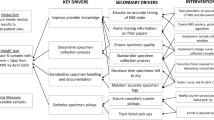Abstract
Objective
To optimize utilization of laboratory tests by measuring baseline rates and appropriateness of investigations, assessing the barriers to rational use, and developing and implementing an educational package for resident doctors.
Design
Quality improvement study.
Setting
Neonatal intensive care unit (NICU) from August, 2015 to December, 2016.
Participants
All neonates admitted in NICU and resident doctors working in NICU.
Intervention
Addressing barriers, educational package, posters and group discussions.
Main outcome measures
Laboratory test rates for hematology, biochemistry and blood gas. Proportion of tests judged to be inappropriate.
Results
At the baseline, median (IQR) laboratory test rate patient/day was 0.6 (0.2–1.5) and one-fifth of tests were classified as inappropriate. Mechanical ventilation and sepsis were independent predictors of laboratory test rates but could explain only 35% of the disparities, indicating variations in clinical practice. Following a short period of intervention, hematology investigations showed a trend towards reduction, though overall test rates did not change significantly.
Conclusions
Addressing barriers, creating awareness and educational interventions were able to bring down hematology laboratory test rates in a short period. A longer period of sustained intervention is required to demonstrate significant effects on test ordering behavior.
Similar content being viewed by others
References
Kwok J, Jones B. Unnecessary repeat requesting of tests: An audit in a government hospital immunology laboratory. J Clin Pathol. 2005;58:457–62.
Zhi M, Ding EL, Theisen-Toupal J, Whelan J, Arnaout R. The landscape of inappropriate laboratory testing: A 15–year meta-analysis. PLoS One. 2013;8:e78962.
Konger RL, Ndekwe P, Jones G, Schmidt RP, Trey M, Baty EJ, et al. Reduction in unnecessary clinical laboratory testing through utilization management at a US government veterans affairs hospital. Am J Clin Pathol. 2016;145:355–64.
Fryer AA, Smellie WSA. Managing demand for laboratory tests: A laboratory toolkit. J Clin Pathol. 2013;66:62–72. WHAT ISALREADY KNOWN? • Inappropriate laboratory investigations increase cost and blood loss, and may lead to more tests and wrong diagnosis, and cause anxiety. WHAT THIS STUDY ADDS? • It is possible to optimize utilization of laboratory tests by addressing local barriers and implementing an educational package.
Krasowski MD, Chudzik D, Dolezal A, Steussy B, Gailey MP, Koch B, et al. Promoting improved utilization of laboratory testing through changes in an electronic medical record: Experience at an academic medical center. BMC Med Inform Decis Mak. 2015;15:11.
National Institute for Health and Care Excellence (NICE). Cost-saving Guidance. Available from: https://doi.org/www.nice.org.uk/about/what-we-do/into-practice/costsaving-guidance. Accessed November 16, 2017.
Morden NE, Colla CH, Sequist TD, Rosenthal MB. Choosing wisely–The politics and economics of labeling low-value services. N Engl J Med. 2014;370:589–92.
Kobewka DM, Ronksley PE, McKay JA, Forster AJ, van Walraven C. Influence of educational, audit and feedback, system based, and incentive and penalty interventions to reduce laboratory test utilization: A systematic review. Clin Chem Lab Med. 2015;53:157–83.
Cetinkaya M, Köksal N, Özkan H. A new scoring system for evaluation of multiple organ dysfunction syndrome in premature infants. Am J Crit Care. 2012;21:328–37.
Robinson A. Rationale for cost-effective laboratory medicine. Clin Microbiol Rev. 1994;7:185–99.
Ullman AJ, Keogh S, Coyer F, Long DA, New K, Rickard CM. “True Blood” The critical care story: An audit of blood sampling practice across three adult, paediatric and neonatal intensive care settings. Aust Crit Care. 2016;29:90–5.
Merlani P, Garnerin P, Diby M, Ferring M, Ricou B. Quality improvement report: Linking guideline to regular feedback to increase appropriate requests for clinical tests: Blood gas analysis in intensive care. BMJ. 2001;323:620–4.
Merkeley HL, Hemmett J, Cessford TA, Amiri N, Geller GS, Baradaran N, et al. Multipronged strategy to reduce routine-priority blood testing in intensive care unit patients. J Crit Care. 2016;31:212–6.
Author information
Authors and Affiliations
Corresponding author
Rights and permissions
About this article
Cite this article
Devarapalli, S., Saini, S.S., Sundaram, V. et al. Optimizing Utilization of Laboratory Investigations in Neonatal Intensive Care Unit. Indian Pediatr 55, 784–787 (2018). https://doi.org/10.1007/s13312-018-1382-5
Received:
Revised:
Accepted:
Published:
Issue Date:
DOI: https://doi.org/10.1007/s13312-018-1382-5




